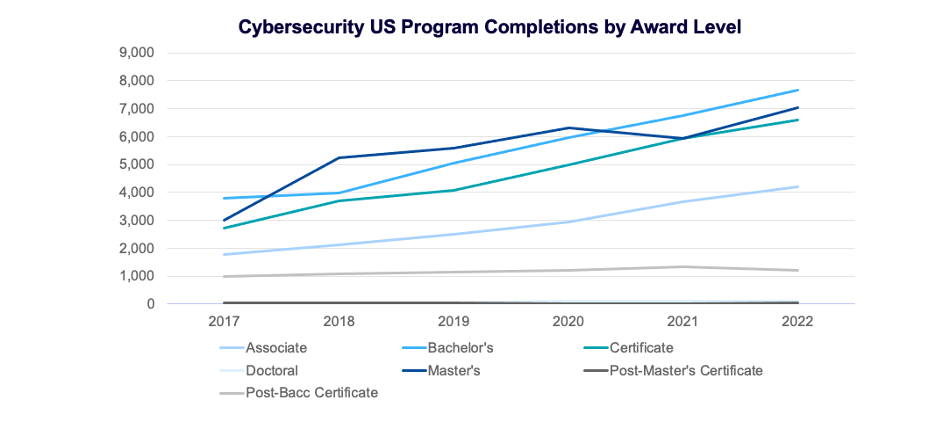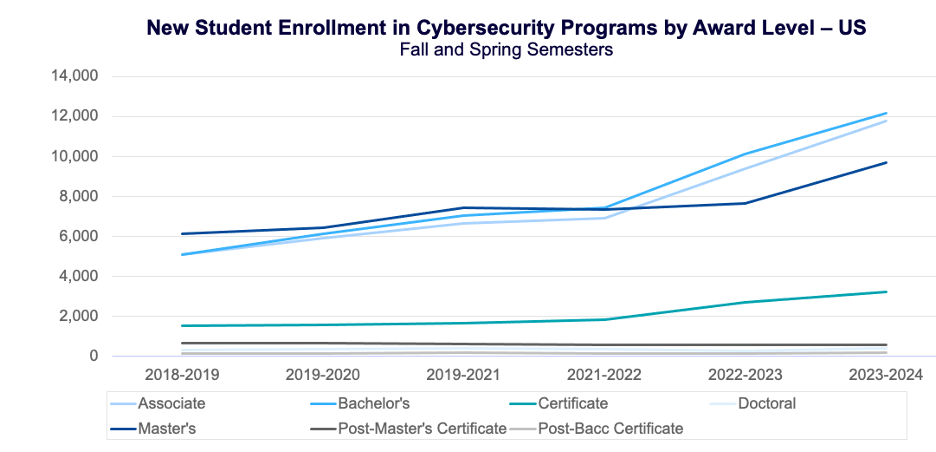In the first half of 2024, an alarming number of US higher education institutions reported major cyberattacks. Massive data breaches occurred at New Mexico Highlands University, East Central University in Oklahoma, and Rowan College in New Jersey, and the count is only growing. In April, Florida Memorial University fell victim to a major cybersecurity attack by INC Ransom. Interestingly, FMU has a strong academic focus on cybersecurity.
Cybersecurity continues to threaten higher education institutions, but ironically, it also represents an opportunity for schools to grow enrollment and establish themselves as leaders in this increasingly important field.
Cybersecurity Program Completions
Completions of cybersecurity programs continue to climb, increasing the number of potential cybercrime fighters in the workforce. Total completions increased from 2017 to 2022, growing from 12,333 graduates in 2017 to 26,864 in 2022. This represents a five-year annual growth rate of 17 percent.

Source: Gray Decision Intelligence Program Evaluation System
In addition, cybersecurity programs are growing across award levels, presenting opportunities for community colleges, small private institutions, and public universities alike. Bachelor’s programs comprised the largest share of cybersecurity completions in 2022, at 28 percent. Master’s programs were close behind at 26 percent, and undergraduate certificate programs accounted for 24 percent of all completions. Associate programs held a 15 percent share, graduate certificates comprised a 4.5 percent share, and doctoral programs were less than one percent.

Source: Gray Decision Intelligence Program Evaluation System
Surging Demand at Community Colleges
While completions are a very useful metric, they reflect program decisions made several years in the past. New student enrollment is a more current indicator of student demand, and according to the most recent data, cybersecurity programs are surging in popularity. 11,790 new students enrolled in associate-level cybersecurity programs in 2023-24, up 26 percent compared to the previous year. New enrollment in undergraduate certificate programs grew by 18 percent.
Four-year institutions benefited from increased interest in cybersecurity programs as well. New student enrollment in master’s programs grew 27 percent year-over-year, and new enrollment in bachelor’s programs grew 20 percent.

Source: Gray Decision Intelligence Program Evaluation System
A Critical Shortage of Cybersecurity Professionals
Growing interest in cybersecurity programs among students is a welcome trend for employers. Experts suggest an urgent need for cybersecurity professionals, and this need is only expected to grow as the US faces increasingly aggressive cybercrime incidents. Cybersecurity Ventures estimates that in 2023, there were more than 750,000 unfilled cybersecurity jobs in the US.
A June 2024 Washington Post article highlighted higher education’s essential role in building out a cybersecurity workforce as soon as possible by increasing their program offerings. As an example:
“George Washington University, which is one of the Department of Homeland Security’s certified Centers of Excellence in the field, expanded its class offerings in cybersecurity, including a partnership with Northern Virginia Community College that awards degrees or helps students work toward basic certification. The program includes cybersecurity boot camps that compress a lot of information into a short period of time.”
Recent Job Postings
Gray DI’s job postings data confirms the need for trained cybersecurity professionals across all types of industries. From January to May 2024, Gray DI tracked over 296,000 job postings related to cybersecurity programs from over 57,000 companies. These jobs pay well – the average salary was $102,552. Over 90 percent of these jobs require some sort of higher education credential; over 62 percent require a bachelor’s degree.
Share of Job Postings in Cybersecurity by Degree

Source: Gray Decision Intelligence Job Postings Dashboard
Companies in the Retail and Wholesale, Information Technology, and Aerospace and Defense industries accounted for the largest share of job postings. Interestingly, the Education sector accounted for five percent of job postings.

Source: Gray Decision Intelligence Job Postings Dashboard.
A Win-Win for Higher Education?
The battle against cybercrime is ongoing. Higher education can play a key role in mitigating the risk and preventing future attacks. As an additional benefit, cybersecurity programs can help institutions grow enrollment and, importantly, provide graduates with abundant job opportunities and high wages.
Looking back: Last November, Gray DI published a blog discussing the impact of major cybersecurity breaches on US higher education institutions and the subsequent increase in student demand for cybersecurity programs.




